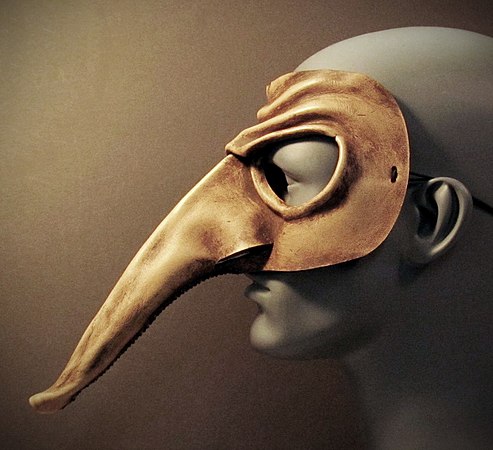History of Western Theatre: Greeks to Elizabethans/Masks
Greek Masks were usually made from wood, cloth, cork, hardened linen or leather and often included human and animal hair as decorative accents. Two small holes for the eyes and tiny holes for the mouth and ears were also included in the mask so that the actor could hear and be heard by the audience and his fellow performers. The reason there are no original Greek masks to study is because they were created out of biodegradable materials and were often sacrificed to the god Dionysus after performances. There is, however, evidence of the masks from paintings on Grecian urns and ceramic wear.

Comic mask were grotesque distortions and parodies of the normal human face. The parts of the face that would most often be distorted were the mouth and eyes, agape or bulging out respectively, to increase the humor or comedic aspects of plays and characters. Comic masks also included representations of gods in human form or anthropomorphic disguise. They usually involved gender bending, males wearing female masks, and highlighted the differences between the sexes for increased comedic effect. These were the masks of the Old Comedic Period in Greece which lasted roughly a century.
The New Comedic Period started around the late 4th century and lasted up until the 2nd Century BC. Masks of this period were starkly more realistic and shifted drastically from the over the top, gender twisted portraits of the earlier comedies. Instead of accentuating gender, masks were instead made to punctuate contrasting stereotypes, such as the stern father and the lovelorn son. The visual emotional differences and contrasts in masks were supposed to create comedy rather than relying on the abuse of gender relationships.
Tragic masks generally had wide open mouths, a sign of lamentation, suffering, or anguish. They were, more often than not, more realistic than comic masks of either period. Tragic masks made the actors wearing them look taller by enlarging the length of the forehead, this being due to the trend in Greek theatre that the taller the character was the more important they were to the story. Tragic figures were almost always taller than figures in comedies as it was the more respected form of theatre during that time.
Special masks were often made for characters that needed to be distinct. The most prominent example being the mask for Oedipus in Oedipus the King. A mask would have had to be specially made to show the unique changes that the character goes through during the course of the play, including gouging his own eyes out.
The reasons that Greeks used masks were many, though some were more important than others. First and foremost, the use of masks was a symbol of worship of the god Dionysus, as they were predominantly seen and used during festivals celebrating the same god. Secondly, the masks provided increased visibility to all the audience members in the koilon. Coupled with the natural acoustics of the outdoor theatre this provided and equally profound performance for all the people in the audience, back rows included. It also gave actors the ability to play multiple characters in a single performance, and expanded the ability of male actors to play female roles, due to the fact that during this time females could only participate in a limited extent in the chorus.
-
A Greek theater mask.
-
Roman terracotta mask of a Satyr.
-
A Zanni mask used in the Itallian Commedia dell'arte.
-
Harlequin, a stock role in Commedia dell'arte, wearing a mask.



